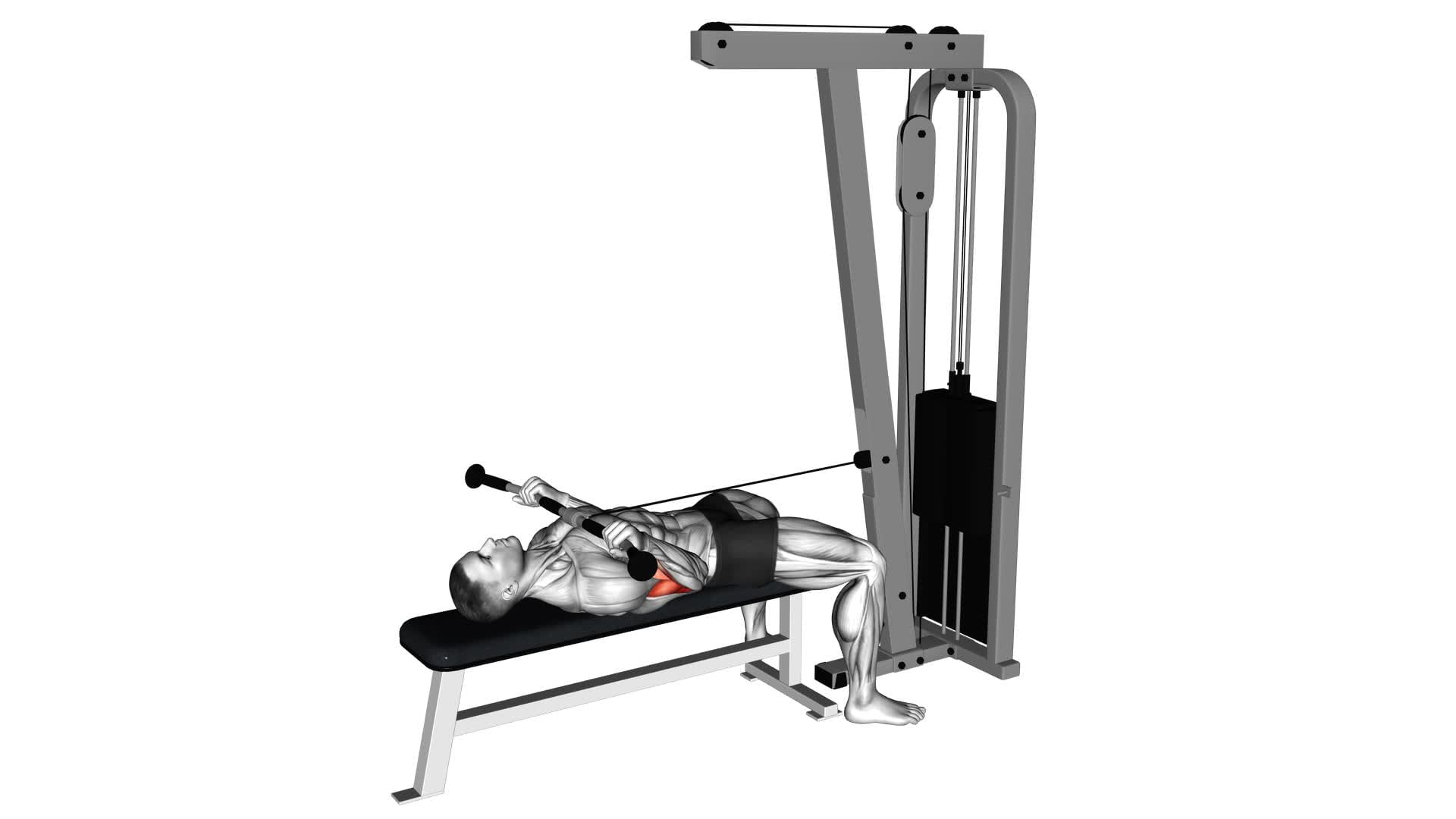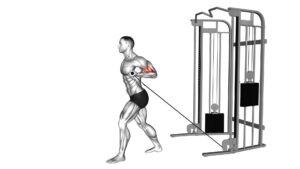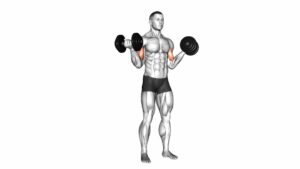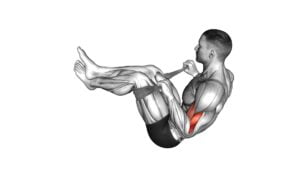Cable Lying Biceps Curl (VERSION 2) – Video Exercise Guide & Tips

Are you looking to strengthen your biceps and build muscle? Look no further than the Cable Lying Biceps Curl (Version 2).
Watch This Exercise Video
In this video exercise guide, we will show you the proper form and technique to maximize your results. Learn about the equipment needed, common mistakes to avoid, and tips to get the most out of this exercise.
Get ready to take your biceps workout to the next level with this effective variation.
Key Takeaways
- Cable lying biceps curl targets and strengthens the biceps while engaging other muscles in the upper body.
- It helps develop stronger and more defined biceps and improves upper body functionality.
- The exercise also engages the brachialis and brachioradialis muscles for forearm and grip strength.
- Proper form and technique, as well as using the correct equipment, minimize the risk of injury and ensure effective results.
Benefits of Cable Lying Biceps Curl (VERSION 2)
What are the benefits of performing Cable Lying Biceps Curl (VERSION 2) for you?
This exercise not only targets and strengthens your biceps but also engages other muscles in your upper body. By using proper breathing techniques and muscle activation techniques, you can maximize the benefits of this exercise.
The Cable Lying Biceps Curl (VERSION 2) primarily targets your biceps brachii, the muscle responsible for flexing your elbow joint. By performing this exercise, you can develop stronger and more defined biceps. Additionally, this exercise also engages your brachialis and brachioradialis muscles, which are important for forearm and grip strength.
Proper breathing techniques are crucial during this exercise. Exhale as you curl the weight up towards your shoulders and inhale as you lower it back down. This helps stabilize your core and ensures efficient oxygen flow to your working muscles.
To further enhance the benefits of Cable Lying Biceps Curl (VERSION 2), focus on muscle activation techniques. Before starting the exercise, mentally engage your biceps and visualize the movement. This helps establish a mind-muscle connection, allowing you to fully activate and target the intended muscles.
Incorporating Cable Lying Biceps Curl (VERSION 2) into your workout routine can lead to increased bicep strength, muscle definition, and improved upper body functionality. Remember to use proper breathing techniques and focus on muscle activation for optimal results.
Equipment Needed for Cable Lying Biceps Curl (VERSION 2)
To perform Cable Lying Biceps Curl (VERSION 2), you'll need specific equipment. This exercise requires a cable machine with an adjustable pulley system and a straight bar attachment. The cable machine provides the necessary resistance to target and activate your biceps effectively.
The straight bar attachment is essential as it allows for a neutral grip, which helps to reduce strain on your wrists and forearms. This grip also promotes optimal bicep activation during the exercise.
If you don't have access to a cable machine, there are alternative exercises that you can perform to target your biceps. Dumbbell curls, hammer curls, and resistance band curls are all great options that can be done with minimal equipment.
It is important to remember that the equipment used for Cable Lying Biceps Curl (VERSION 2) plays a significant role in targeting your biceps effectively. Using the correct equipment will ensure proper form and technique, leading to optimal results and minimizing the risk of injury.
Now that you understand the equipment needed for this exercise, let's move on to the next section, where we'll discuss the proper form and technique for Cable Lying Biceps Curl (VERSION 2).
Proper Form and Technique for Cable Lying Biceps Curl (VERSION 2)
To properly execute Cable Lying Biceps Curl (VERSION 2), you need to focus on maintaining correct form and technique throughout the exercise. This exercise primarily targets your biceps muscles, but also engages your forearms and shoulders. Grip strength plays a crucial role in this exercise, as it allows you to maintain control and stability during the movement.
To begin, lie flat on your back on a bench positioned perpendicular to the cable machine. Grasp the handles with an underhand grip, keeping your hands shoulder-width apart. Your arms should be fully extended, perpendicular to the floor. Engage your core and keep your back flat against the bench throughout the exercise.
While maintaining a stable upper body, slowly bend your elbows and curl the handles towards your forehead. Keep your upper arms stationary and only move your forearms. Squeeze your biceps at the top of the movement for a brief pause, then slowly lower the handles back to the starting position.
To maximize muscle activation, focus on using your biceps to perform the movement rather than relying on momentum. Keep the tension on your biceps throughout the entire range of motion. Control the weight and avoid swinging or using your shoulders to lift the handles.
Common Mistakes to Avoid During Cable Lying Biceps Curl (Version 2)
To ensure proper form during the Cable Lying Biceps Curl (Version 2), pay attention to your grip technique. Avoid gripping the handles too tightly, as this can limit your range of motion and decrease the effectiveness of the exercise.
Additionally, be mindful of your elbow positioning. Keep your elbows stationary throughout the movement, avoiding any swinging or excessive movement.
Lastly, maintain lower back stability by keeping your core engaged and avoiding any arching or rounding of the spine.
Grip Technique Tips
Ensure a secure grip on the cable handle to maximize effectiveness and prevent potential injuries during the Cable Lying Biceps Curl (Version 2). Here are some grip technique tips to help you improve your grip strength and activate your forearms properly:
- Maintain a firm grip: Avoid letting the cable handle slip from your hands by holding it firmly throughout the exercise.
- Use an underhand grip: Hold the cable handle with your palms facing up to engage the biceps and forearms more effectively.
- Don't squeeze too tightly: While maintaining a firm grip, avoid squeezing the handle excessively, as it can lead to unnecessary tension in your forearms.
- Keep your wrists neutral: Avoid excessive flexion or extension of your wrists during the exercise to prevent strain or discomfort.
- Don't let the handle rotate: Ensure the cable handle remains stable and doesn't rotate in your hands throughout the movement, maintaining constant tension on the biceps.
Elbow Positioning Mistakes
To avoid elbow positioning mistakes during the Cable Lying Biceps Curl (Version 2), make sure you maintain proper form and alignment throughout the exercise. Incorrect elbow positioning can lead to discomfort and even pain in the elbows, so it's important to pay attention to this aspect of the exercise.
Firstly, ensure that your elbows are stationary and don't move forward or backward during the movement. This will help target the biceps effectively while minimizing stress on the elbows.
Additionally, keep your elbows close to your sides throughout the exercise. Avoid allowing them to flare out, as this can strain the elbow joint. By following these elbow positioning tips, you can prevent elbow pain and perform the Cable Lying Biceps Curl (Version 2) safely and effectively.
Now, let's move on to addressing lower back stability issues.
Lower Back Stability Issues
Avoid arching your lower back during the Cable Lying Biceps Curl (Version 2) to maintain proper stability and prevent strain. When performing this exercise, it's crucial to prioritize the health and safety of your lower back. Here are some common mistakes to avoid in order to prevent back pain and maximize the effectiveness of your strengthening exercises:
- Keep your core engaged throughout the movement to stabilize your lower back.
- Ensure that your lower back stays flat against the bench or floor, avoiding any excessive arching.
- Maintain proper form by avoiding any jerking or swinging motions.
- Use a weight that challenges you without compromising your lower back stability.
- Focus on controlling the movement and avoid using momentum to lift the weight.
By following these guidelines, you can reduce the risk of lower back pain and optimize the results of your Cable Lying Biceps Curl (Version 2).
Now, let's move on to some tips to maximize your results with this exercise.
Tips to Maximize Results With Cable Lying Biceps Curl (Version 2)
To maximize results with Cable Lying Biceps Curl (Version 2), it's crucial to focus on proper form throughout the exercise. This ensures that you're effectively targeting your bicep muscles and minimizing the risk of injury.
Additionally, incorporating the progressive overload technique by gradually increasing the resistance or weight over time will help you continually challenge your muscles and promote growth.
Proper Form Importance
Focus on maintaining proper form during the Cable Lying Biceps Curl (Version 2) to maximize your results. Proper form is essential for achieving the full benefits of this exercise and avoiding injury.
Here are some tips to help you maintain proper form:
- Keep your back flat against the bench throughout the movement.
- Engage your core muscles to stabilize your body.
- Bend your elbows and curl the handles towards your shoulders in a controlled manner.
- Keep your wrists straight and avoid excessive wrist flexion or extension.
- Lower the handles back down to the starting position without swinging or using momentum.
By following these guidelines, you ensure that the intended muscles are being targeted effectively, leading to better gains in strength and muscle definition.
Targeting Bicep Muscles
To effectively target your bicep muscles and maximize your results with the Cable Lying Biceps Curl (Version 2), consistently maintain proper form and engage your core muscles throughout the exercise.
This exercise specifically targets the bicep muscles, helping to increase their strength and size. By using the cable machine, you can adjust the resistance to suit your fitness level and gradually increase it as you get stronger.
In addition to the Cable Lying Biceps Curl (Version 2), there are alternative exercises that can also effectively target your bicep muscles, such as dumbbell curls, barbell curls, and hammer curls. These exercises provide variety and challenge your muscles in different ways, promoting growth and development.
Now, let's explore the progressive overload technique to further enhance your bicep muscle gains.
Progressive Overload Technique
To maximize your results with the Cable Lying Biceps Curl (Version 2), consistently challenge yourself by gradually increasing the resistance. By implementing progressive overload techniques, you can optimize bicep growth and push your muscles to adapt and become stronger.
Here are some tips to help you effectively apply this technique:
- Increase the weight: Gradually add more weight to the cable machine to continuously challenge your biceps.
- Adjust the reps and sets: Increase the number of repetitions or sets you perform to further stimulate muscle growth.
- Decrease rest time: Shortening the rest periods between sets can increase the intensity of your workout and promote muscle growth.
- Utilize drop sets: Perform a set with a challenging weight, then immediately reduce the weight and continue the exercise to fatigue your muscles.
- Incorporate supersets: Alternate between the Cable Lying Biceps Curl and another exercise targeting a different muscle group to maximize your workout efficiency.
Variations and Modifications for Cable Lying Biceps Curl (VERSION 2)
Try incorporating different grips to challenge your biceps even more during the Cable Lying Biceps Curl (VERSION 2).
Variations and modifications can help you target different areas of your biceps and add variety to your workout routine. One variation you can try is using an underhand grip. This involves holding the handles with your palms facing up. This grip targets the biceps brachii muscles more directly and can provide a greater contraction.
Another variation is the overhand grip, where you hold the handles with your palms facing down. This grip puts more emphasis on the brachialis muscle, which is located underneath the biceps.
You can also modify the exercise by adjusting the weight or resistance. Increasing the weight will make the exercise more challenging, while decreasing it can be helpful if you're just starting out or recovering from an injury.
Additionally, you can experiment with different cable attachments, such as a straight bar or rope, to change the grip and engage your biceps in different ways.
Frequently Asked Questions
Can the Cable Lying Biceps Curl (Version 2) Help in Building Overall Arm Strength?
Yes, the cable lying biceps curl (version 2) can definitely help in building overall arm strength. This exercise specifically targets the biceps muscles, which are essential for arm strength.
Cable exercises, like this one, provide constant tension throughout the movement, maximizing muscle activation and promoting muscle growth.
How Often Should I Perform the Cable Lying Biceps Curl (Version 2) in My Workout Routine?
To maximize the benefits of the cable lying biceps curl (version 2) in your workout routine, it's important to consider how often you should perform this exercise.
The frequency of performing this exercise depends on your fitness goals and current level of arm strength. It's generally recommended to include this exercise 2-3 times a week in your routine to allow for proper muscle recovery and growth.
Remember to consult with a fitness professional to tailor your workout routine to your specific needs.
Is It Necessary to Use a Specific Type of Cable Machine for the Cable Lying Biceps Curl (Version 2)?
To perform the cable lying biceps curl (version 2), you don't necessarily need to use a specific type of cable machine. However, it's important to ensure that the cable machine you use is suitable for this exercise.
The cable machine should have a low pulley and a weight stack for you to select the appropriate resistance. It's also crucial to maintain proper exercise technique to effectively target your biceps muscles and avoid any potential injuries.
Can the Cable Lying Biceps Curl (Version 2) Be Done With a Partner or Spotter?
Yes, you can perform the cable lying biceps curl (version 2) with a partner or spotter.
Partner assistance can be beneficial to ensure proper form and technique during the exercise. They can help you maintain the correct position and provide support if needed.
This can help reduce the risk of injury and maximize the effectiveness of the exercise.
Remember to communicate with your partner and coordinate your movements for a safe and efficient workout.
Are There Any Specific Warm-Up Exercises or Stretches Recommended Before Performing the Cable Lying Biceps Curl (Version 2)?
To prepare for the cable lying biceps curl (version 2), it's important to warm up your muscles and joints. Incorporate dynamic stretches like arm swings and wrist rotations to increase blood flow and flexibility. These exercises will help prevent injury and improve your performance during the curl.
Remember to always listen to your body and stop if you feel any pain or discomfort.
Now, let's dive into the specific warm-up exercises and stretches for the cable lying biceps curl (version 2).
Conclusion
In conclusion, the cable lying biceps curl (Version 2) is a highly effective exercise for targeting the biceps muscles. By using the cable machine, you can maintain constant tension throughout the movement, leading to better muscle activation and growth.
It's important to maintain proper form and avoid common mistakes to maximize results. Additionally, there are variations and modifications available to cater to different fitness levels and goals.
Incorporate this exercise into your routine for stronger and more defined biceps.

Author
Years ago, the spark of my life’s passion ignited in my mind the moment I stepped into the local gym for the first time. The inaugural bead of perspiration, the initial endeavor, the very first surge of endorphins, and a sense of pride that washed over me post-workout marked the beginning of my deep-seated interest in strength sports, fitness, and sports nutrition. This very curiosity blossomed rapidly into a profound fascination, propelling me to earn a Master’s degree in Physical Education from the Academy of Physical Education in Krakow, followed by a Sports Manager diploma from the Jagiellonian University. My journey of growth led me to gain more specialized qualifications, such as being a certified personal trainer with a focus on sports dietetics, a lifeguard, and an instructor for wellness and corrective gymnastics. Theoretical knowledge paired seamlessly with practical experience, reinforcing my belief that the transformation of individuals under my guidance was also a reflection of my personal growth. This belief holds true even today. Each day, I strive to push the boundaries and explore new realms. These realms gently elevate me to greater heights. The unique combination of passion for my field and the continuous quest for growth fuels my drive to break new ground.







